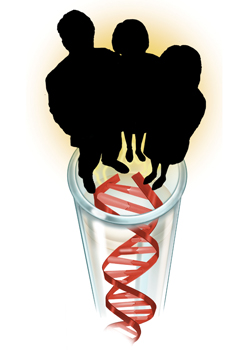
illustration by Dominc Doyle, Medical Art Group
New databank to be a trove of anonymous DNA information
The successful sequencing of the human genome several years ago opened the door for a new era in medicine, one with treatments “tailored” to fit an individual patient's genetic profile.
Crossing the threshold of this doorway will require very large-scale research efforts to find the key links between genes and disease, and between genes and drug response.
To help investigators uncover those links, Vanderbilt University Medical Center is beginning to build an anonymous database of genetic and clinical information.
“The establishment of this database will allow researchers to more effectively and efficiently conduct important genetic research, which in turn will help improve care for patients, so it's a win-win for everyone,” said Gordon R. Bernard, M.D., assistant vice chancellor for Research.
The database resource will use blood that would otherwise be discarded to obtain anonymous genetic samples. These “banked” samples will be associated with clinical data extracted from medical records without information that identifies those records.
Investigators will be able to use the resource to look for patterns and parallels between patients with similar diseases or who have taken similar medications.
“We've known for a long time that individuals respond differently to drugs, and in some cases, we know the genetic reasons for these differences,” said Dan M. Roden, M.D., director of the John A. Oates Institute for Experimental Therapeutics and principal investigator of the DNA Databank effort. “When we understand the genetic variations that affect drug response more fully, we will be able to avoid rare, but catastrophic, side effects, and we will be able to identify patients with the greatest chance of responding well to a particular drug therapy.”
Finding patterns and parallels among the billions of “letters” of DNA — to narrow in on genes that influence drug response or cause disease — requires large numbers of samples.
“We're most interested in finding the genes that predict common, complex diseases, like diabetes, Alzheimer’s disease, cancer and heart disease,” said Jonathan L. Haines, Ph.D., director of the Vanderbilt Center for Human Genetics Research. “These kinds of diseases have multiple genetic and environmental contributions, so statistically we need many, many patient samples to have a hope of finding the links. Having access to more detailed clinical information will also help us to find these genes.”
Haines and collaborators have made recent advances in identifying genes associated with disease. The investigators reported earlier this year, for example, that a certain genetic variant increases an individual's risk of age-related macular degeneration, the leading cause of vision loss and legal blindness in people over age 60. The hope, Haines said, is to use this knowledge to test individuals and begin treatments before symptoms of the degeneration ever surface.
The new VUMC database is exactly the type of resource needed to apply this model more broadly, to ultimately find the genes that can lead to predictive tests and preventive therapies for many, if not all, diseases, Haines said.
VUMC hopes to build the database at the rate of 50,000 samples per year, with the ultimate goal of having over 1 million samples, said Jill Pulley, M.B.A., director of the DNA Databank resource.
Patient blood that would normally be discarded after testing will be used as the starting material for DNA samples. A set of computer algorithms will permanently encrypt the sample identifiers. Another set of computer algorithms will remove all identifying information — for example name, address, and Social Security number — from the medical record and link the remaining anonymous clinical information to the DNA sample.
The computer programs ensure that it is not possible to determine the identity of patients from the DNA samples or clinical information.
“The computing tools that we are developing to build this resource substantially exceed federal requirements for securing patient privacy,” said Daniel R. Masys, M.D., professor and chair of Biomedical Informatics. “As a result, investigators using records derived from the database will only receive anonymous information and only the information they need to conduct their research.”
“This resource offers a way for every patient to participate in medical research, with no privacy or safety risk — or even any inconvenience — to our patients,” Pulley said. “The blood that is normally discarded every day is a rich source of information that should be harnessed to improve treatment for future patients.”
Any VUMC patient over 18 years of age who has blood drawn is eligible for inclusion in the database. However, Vanderbilt recognizes that some patients will not wish to have their discarded blood used for research, even anonymously. These patients have the option of not being included.
The computer algorithms will also randomly exclude samples from the database, making it impossible to know whether any individual patient has been included.
All Vanderbilt investigators are invited to develop protocols that utilize the resource. Vanderbilt's independent institutional review board will have oversight of these studies, and also of Databank operations.
It is the hope of all involved, Pulley said, that the information gleaned from the DNA Databank resource will lead to improved diagnosis and treatment of disease as well as to new methods for customizing patient care in the future.













